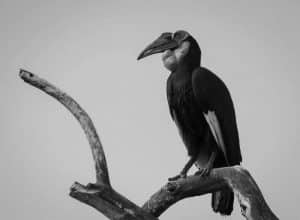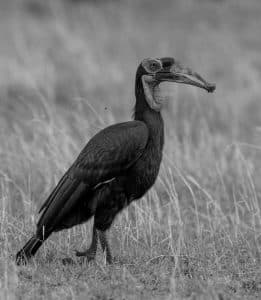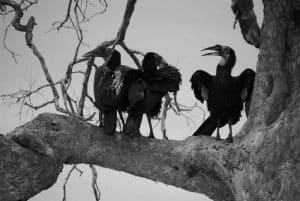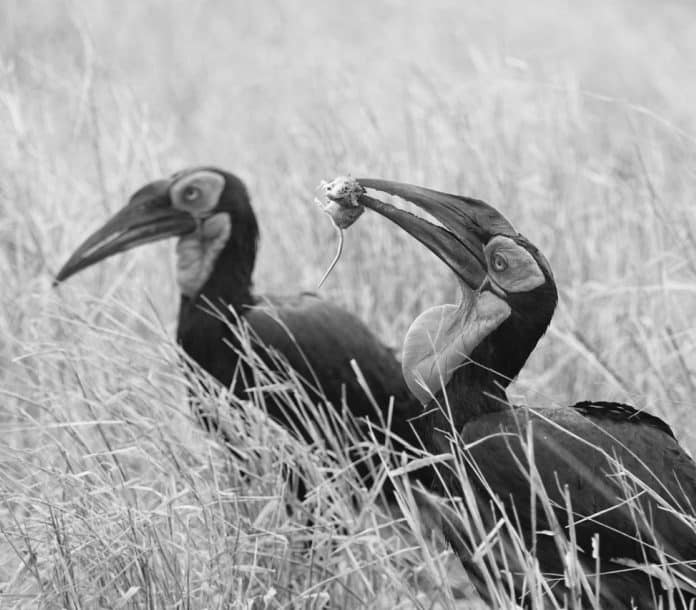Introduction to the Southern Ground-Hornbill
Welcome to the enchanting world of the Southern Ground-Hornbill, a majestic bird that graces the Tanzanian savannahs with its thunderous footsteps and awe-inspiring presence. The scientific name of this remarkable bird is Bucorvus leadbeateri, and it is a member of the hornbill family. The Southern Ground-Hornbill in Tanzania is known for its striking appearance, with its large size, black plumage, and vibrant red facial skin. They are truly a sight to behold as they roam the open grasslands and woodlands of Tanzania, emitting their deep, booming calls that echo across the plains. These iconic birds play a significant role in the ecosystem, and their presence is deeply intertwined with the rich biodiversity of the Tanzanian savannahs.

The Southern Ground-Hornbill’s distribution in Tanzania is primarily concentrated in the eastern and southern regions of the country, including areas such as the Serengeti National Park, Selous Game Reserve, and Ruaha National Park. These expansive and diverse landscapes provide the ideal habitat for the Southern Ground-Hornbill, offering a mix of open grasslands, scattered trees, and access to water sources. Their presence in these regions is a testament to the unique and vital role they play in the delicate balance of the Tanzanian ecosystems.
Habitat and Distribution of Southern Ground-Hornbills in Tanzania
The Southern Ground-Hornbill is a highly adaptable bird that thrives in a variety of habitats within the Tanzanian savannahs. They are commonly found in open woodlands, savannah grasslands, and even semi-arid areas, displaying their remarkable ability to coexist with diverse environmental conditions. These birds are also known to inhabit both protected areas and communal lands, showcasing their resilience in the face of human activities and land use patterns. The distribution of Southern Ground-Hornbills in Tanzania reflects their preference for habitats with a mix of open spaces for foraging and scattered trees for nesting and roosting. This specialized habitat requirement underscores the importance of conserving these unique landscapes to ensure the continued presence of the Southern Ground-Hornbill in Tanzania.
Behavior and Social Structure of Southern Ground-Hornbills
The behavior and social structure of Southern Ground-Hornbills are a fascinating aspect of their existence in the Tanzanian savannahs. These birds are known for their strong social bonds and complex communication patterns, which are essential for their survival and reproductive success. Southern Ground-Hornbills form tight-knit family groups, consisting of an alpha male and female, along with subordinate individuals that assist in raising and protecting the young. Their cooperative breeding system involves collective efforts in foraging, territory defense, and caring for the offspring, highlighting the intricate social dynamics at play within their groups. Additionally, their distinctive booming calls and elaborate displays serve as means of communication and territorial signaling, contributing to the vibrant tapestry of sounds that resonate through the Tanzanian wilderness.
Conservation Status of Southern Ground-Hornbills in Tanzanian Savannahs
The conservation status of Southern Ground-Hornbills in the Tanzanian savannahs is a matter of great concern, as these iconic birds face various threats and challenges that jeopardize their long-term survival. The International Union for Conservation of Nature (IUCN) has classified the Southern Ground-Hornbill as vulnerable, highlighting the urgent need for concerted efforts to protect and preserve their populations in Tanzania. The primary factors contributing to their vulnerable status include habitat loss and fragmentation, poaching, electrocution from power lines, and human-wildlife conflict. These cumulative threats underscore the precarious position of the Southern Ground-Hornbill in the rapidly changing landscapes of Tanzania, necessitating proactive measures to safeguard their future.
Threats and Challenges Facing Southern Ground-Hornbills in Tanzania

The Southern Ground-Hornbills in Tanzania are confronted by a myriad of threats and challenges that pose significant risks to their survival. Habitat loss and degradation due to agricultural expansion, infrastructure development, and deforestation have significantly impacted the availability of suitable habitats for these birds. The conversion of natural landscapes into human-dominated areas has fragmented their populations, leading to isolation and reduced genetic diversity. Furthermore, the illegal wildlife trade and poaching pose a severe threat to Southern Ground-Hornbills, as they are sought after for traditional medicine and cultural practices. Additionally, collisions with power lines and electrocution have emerged as serious concerns, leading to mortality and injury among these birds. Addressing these multifaceted challenges requires a comprehensive and integrated approach to conservation that addresses the root causes of these threats.
Efforts and Initiatives for Southern Ground-Hornbill Conservation in Tanzania
Despite the daunting challenges facing Southern Ground-Hornbills in Tanzania, there are various efforts and initiatives aimed at conserving and protecting these remarkable birds. Conservation organizations, government agencies, and local communities are actively involved in initiatives focused on habitat restoration, anti-poaching patrols, community-based conservation programs, and research projects to monitor and study Southern Ground-Hornbill populations. These collaborative endeavors seek to mitigate the impact of habitat loss, address human-wildlife conflict, and raise awareness about the conservation status of the Southern Ground-Hornbill. Furthermore, partnerships with local communities and stakeholders are instrumental in implementing sustainable land management practices and fostering coexistence between people and wildlife. These collective actions demonstrate a commitment to securing a future for Southern Ground-Hornbills in the Tanzanian savannahs.
Importance of Southern Ground-Hornbills in Tanzanian Ecosystems
The Southern Ground-Hornbills play a vital role in the intricate tapestry of Tanzanian ecosystems, contributing to the balance and diversity of the natural landscape. As apex predators, these birds help regulate insect populations and small vertebrates, exerting a top-down influence on the ecosystem dynamics. Their foraging behavior and seed dispersal activities also contribute to the regeneration and maintenance of plant communities, influencing the composition and structure of the savannah vegetation. Moreover, the presence of Southern Ground-Hornbills serves as an indicator of ecosystem health, reflecting the integrity and resilience of the habitats they inhabit. Recognizing the ecological significance of these birds underscores the importance of their conservation in safeguarding the overall biodiversity and ecological processes in the Tanzanian savannahs.
Research and Studies on Southern Ground-Hornbills in Tanzania
Research and studies on Southern Ground-Hornbills in Tanzania have provided valuable insights into their behavior, ecology, and conservation needs. Scientific investigations have focused on tracking the movements and breeding ecology of these birds, shedding light on their habitat requirements and population dynamics. Additionally, research efforts have explored the impacts of human activities on Southern Ground-Hornbill populations, informing conservation strategies and management interventions. Collaborative research endeavors involving local and international experts have facilitated the collection of data on the distribution, abundance, and genetic diversity of these birds, aiding in the formulation of evidence-based conservation plans. The findings from these studies contribute to a deeper understanding of the Southern Ground-Hornbill’s role in Tanzanian ecosystems and guide conservation actions to ensure their continued presence in the wild.
Ecotourism and Southern Ground-Hornbill Observation in Tanzanian Savannahs

Ecotourism offers a unique opportunity for people to experience the majesty of Southern Ground-Hornbills in their natural habitat while contributing to their conservation. In Tanzania, ecotourism initiatives centered around birdwatching and wildlife observation provide visitors with the chance to encounter these iconic birds and appreciate their significance in the savannah ecosystems. Guided tours and safari experiences offer a glimpse into the world of Southern Ground-Hornbills, allowing enthusiasts to witness their behavior, calls, and interactions within the wild landscapes of Tanzania. By engaging in responsible ecotourism practices, visitors can support local communities, conservation efforts, and the sustainable management of natural resources. The promotion of ecotourism not only fosters appreciation for the Southern Ground-Hornbill but also generates economic incentives for the protection of their habitats and the well-being of local communities.
Conclusion and Call to Action for Southern Ground-Hornbill Conservation
In conclusion, the presence of Southern Ground-Hornbills in the Tanzanian savannahs is a testament to the beauty and diversity of the natural world. These iconic birds embody the spirit of the African wilderness, enriching the landscapes with their imposing stature and resonant calls. However, the conservation of Southern Ground-Hornbills in Tanzania is at a critical juncture, as they confront a myriad of threats that imperil their future. It is imperative for individuals, organizations, and governments to take action in safeguarding these magnificent birds and the habitats they rely on. By supporting conservation efforts, raising awareness, and advocating for the protection of Southern Ground-Hornbills, we can ensure that future generations have the opportunity to witness the thunderous footsteps of these awe-inspiring birds echoing across the Tanzanian savannahs. Together, let us unite in our commitment to preserve the Southern Ground-Hornbill and secure a sustainable future for wildlife and people alike.

































